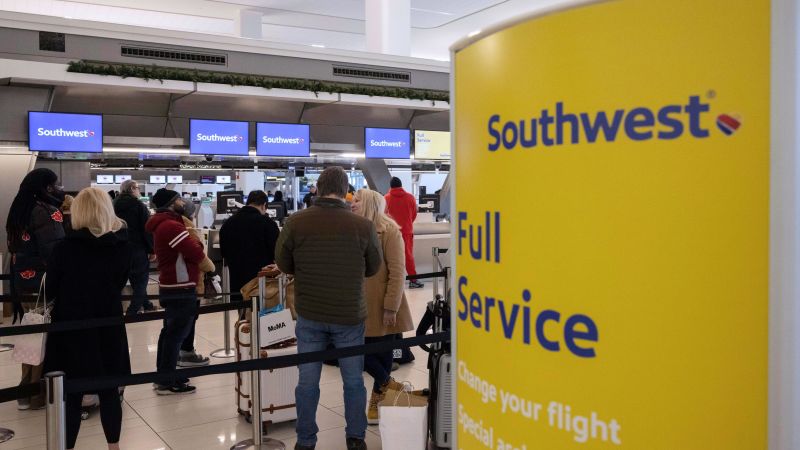Minneapolis
CNN
—
When the coronavirus pandemic ground the transportation industry to a screeching halt in early 2020, the US government doled out more than $54 billion in aid to help pay employees and keep the systems from buckling.
Southwest Airlines received more than $7 billion from that program. But its system had two major meltdowns in the past 18 months, including this week’s massive system failure the likes of which the aviation industry has never seen.
However, analysts say, Southwest’s service meltdown is unrelated to the taxpayer assistance the airline received in 2020. Although undoubtedly aggravating for stranded travelers, the billions of dollars taxpayers forked over to Southwest could not have been directed to solve the particular problems that caused this week’s snafu.
[The pandemic aid] “is water under the bridge at this point,” said Robert Mann, a Port Washington, New York-based airline industry analyst. “The only distinguishing factors at this point are to what degree carriers have satisfied obligations that permit them to either return to paying dividends or return to paying higher officer salaries.”
When air travel plunged in early 2020, the government stepped in with financial assistance to keep the airlines running. Preventing layoffs and furloughs in the transportation sector was a critical focal point as employees such as pilots are subject to training requirements and other certifications that, if lagged, could significantly disrupt air travel for a considerable time.
The Payroll Support Program, which started in March 2020 and was reupped two times in 2021, was similar in nature to the Payroll Protection Program that was meant to help smaller businesses keep employees paid and working during the pandemic.
The federal aid to airlines, which was a mix of grants and loans, came with some caveats: The airlines had to use the funds exclusively to continue paying wages, salaries and benefits to employees; and, for specific periods of time, they couldn’t conduct furloughs or layoffs; issue dividends or stock buybacks; or increase pay for executives.
By the carriers and airline unions’ accounts, the program ultimately was a success.
“It worked,” Gary Kelly, Southwest’s former chief executive officer, said in December 2021 during a Senate Committee on Commerce, Science and Transportation hearing to examine the impact of the PSP.
“Funds received through each round of the PSP were only used for qualifying employee salaries, wages, and benefits,” he added. “We did not cut pay rates; we did not cut hours; we did not cut benefits; we did not layoff; we did not furlough. We actually raised our minimum pay to $15 per hour, effective August 1, 2021.”
Kelly noted that Southwest’s financially conservative approach that put it in a healthy position entering 2020, and the airline’s cost-cutting throughout the pandemic, had it on good footing for the future.
But this wasn’t a short-term event. As the pandemic spread and the virus evolved, demand bottomed out for travel, straining airlines’ operations. To save on costs, and to avoid layoffs, airlines including Southwest offered voluntary buyouts, leaves of absence and early retirement packages.
Earlier this year, as Southwest and other airlines struggled with staffing shortages, two House Democrats asked the Treasury Department’s inspector general to investigate whether any of the PSP funds were used for the buyouts, which ultimately helped contribute to staffing shortages and service disruptions when demand returned.
Experts, employees and even the CEO admit that Southwest’s mess was decades in the making.
Southwest’s meltdown this past weekend, a massive cascading wave of cancellations that stranded tens of thousands of passengers and overwhelming the airline’s internal systems, were a culmination of issues brewing for years, Captain Casey Murray, president of the Southwest Airlines Pilots Association told CNN this week.
“We’ve been having these issues for the past 20 months,” he told CNN. “We’ve seen these sorts of meltdowns occur on a much more regular basis and it really just has to do with outdated processes and outdated IT.”
Murray noted that Southwest’s ancient scheduling system hasn’t changed much since the 1990s. Chief Operating Officer Andrew Watterson told employees this week that the outdated scheduling system was the main culprit for the outage.
Southwest’s “point-to-point” model also didn’t help. The operational approach involves planes flying consecutive routes, picking up crews at those locations and relying on short turnaround times.
“When they have cancellations in one area, it really ripples through, because they don’t necessarily have their crews and their pilots in the right positions,” said Jeff Windau, senior equity analyst of equity research for Edward Jones. “They just kind of build on from city to city to city, and when that gets disrupted, it’s very difficult to get the operations flowing smoothly again.”
Southwest acknowledged many of the concerns raised by Murray and others.
“Part of what we’re suffering is a lack of tools,” Southwest CEO Bob Jordan told employees in a memo obtained by CNN. “We’ve talked an awful lot about modernizing the operation, and the need to do that.”
The PSP amounts were based on the carriers’ 2019 salary levels, which themselves were based on pre-pandemic flying levels. In April 2020, airline passenger traffic plummeted 96% and stayed 60% below 2019 levels in 2020, according to the US Government Accountability Office.
“No carrier was operating a 2019 level of flying,” Mann said. “In fact, while saying ‘no layoffs,’ numerous carriers cut hours and related pay. Many others initiated voluntary separation agreements that paid fewer hours and salary dollars over a defined future period in exchange for early retirements or similar.”
Mann said that means it’s highly unlikely that any airline paid the full amount of PSP to salaries. Where did the excess PSP money go?
“Could have been as simple as fuel, interest payments, other overheads,” he said. “But the idea that PSP would have paid for IT upgrades that a carrier saw no need for is not realistic.”
But Southwest will have to focus on its technology after its service meltdown.
“Now that the problem has occurred, and at [the Department of Transportation] and the market’s urging, I suspect the carrier has a different view of what IT upgrades are necessary,” he said. “They’ll spend their own money now to research, develop and implement new systems.”
Staffing issues also contributed to both of Southwest’s recent service outages, even if it wasn’t the primary factor in the latest meltdown.
Southwest, like other airlines – and other industries – has struggled with staffing shortages amid the recovery from the pandemic.
“The entire industry has been running, I won’t say running on empty, but running on reserve,” Mann said.
In October 2021, Southwest had 7,000 fewer employees than it did pre-pandemic, according to Transportation Department data. The airline cited “inadequate staffing” following the cancellation of more than 2,000 flights during the Indigenous Peoples Day/Columbus Day weekend.
“We are still not where we want to be with staffing, and in particular with our flight crews,” then-COO Mike Van de Ven said in a recorded video to employees. A transcript of the recording was shared with CNN at the time. “We simply need more staffing cushion for the unexpected in this environment and we are bringing new people on board every day,” he said.
Southwest will attempt to move forward from its pitfalls under the watchful eye of the US government.
The Department of Transportation said it is investigating Southwest’s spate of cancellations and customer service delays. President Joe Biden said his administration “is working to ensure airlines are held accountable.”
Democratic Sens. Ed Markey of Massachusetts and Richard Blumenthal of Connecticut issued a new letter Tuesday calling on Southwest to pay up for what they say were avoidable holiday cancellations.
“Southwest is planning to issue a $428 million dividend next year – the company can afford to do right by the consumers it has harmed,” they wrote. “Southwest should focus first on its customers stranded at airports and stuck on interminable hold.”
US Senator Maria Cantwell, who chaired the Senate committee hearing last year, issued a statement Tuesday pledging the panel would be looking into the causes behind Southwest Airlines cascade of flight cancellations.
“The problems at Southwest Airlines over the last several days go beyond weather,” she said in a statement. “The committee will be looking into the causes of these disruptions and its impact on consumers.”
– CNN’s Ted Barrett, Lauren Fox, David Goldman, and Chris Isidore contributed to this report.
Sumber: www.cnn.com






